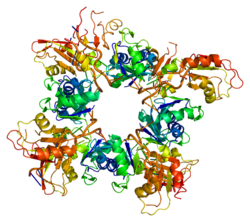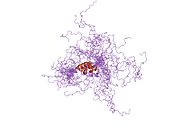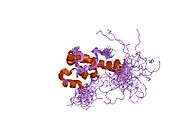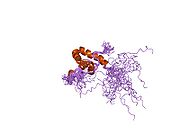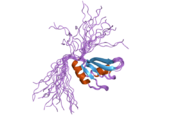- PABPC1
-
Polyadenylate-binding protein 1 is a protein that in humans is encoded by the PABPC1 gene.[1]
The poly(A)-binding protein (PAB or PABP), which is found complexed to the 3-prime poly(A) tail of eukaryotic mRNA, is required for poly(A) shortening and translation initiation. In humans, the PABPs comprise a small nuclear isoform and a conserved gene family that displays at least 3 functional proteins: PABP1 (PABPC1), inducible PABP (iPABP, or PABPC4; MIM 603407), and PABP3 (PABPC3; MIM 604680). In addition, there are at least 4 pseudogenes, PABPCP1 to PABPCP4.[supplied by OMIM][2]
Interactions
PABPC1 has been shown to interact with ANAPC5,[3] GSPT2,[4] CNOT7,[5] PAIP1,[6][7] Eukaryotic translation initiation factor 4 gamma,[8] EIF4G3[8] and PAIP2.[9]
References
- ^ Grange T, de Sa CM, Oddos J, Pictet R (Aug 1987). "Human mRNA polyadenylate binding protein: evolutionary conservation of a nucleic acid binding motif". Nucleic Acids Res 15 (12): 4771–87. doi:10.1093/nar/15.12.4771. PMC 305917. PMID 2885805. http://www.pubmedcentral.nih.gov/articlerender.fcgi?tool=pmcentrez&artid=305917.
- ^ "Entrez Gene: PABPC1 poly(A) binding protein, cytoplasmic 1". http://www.ncbi.nlm.nih.gov/sites/entrez?Db=gene&Cmd=ShowDetailView&TermToSearch=26986.
- ^ Koloteva-Levine, Nadejda; Pinchasi Dalia, Pereman Idan, Zur Amit, Brandeis Michael, Elroy-Stein Orna (May. 2004). "The Apc5 Subunit of the Anaphase-Promoting Complex/Cyclosome Interacts with Poly(A) Binding Protein and Represses Internal Ribosome Entry Site-Mediated Translation". Mol. Cell. Biol. (United States) 24 (9): 3577–87. doi:10.1128/MCB.24.9.3577-3587.2004. ISSN 0270-7306. PMC 387753. PMID 15082755. http://www.pubmedcentral.nih.gov/articlerender.fcgi?tool=pmcentrez&artid=387753.
- ^ Hoshino, S; Imai M, Kobayashi T, Uchida N, Katada T (Jun. 1999). "The eukaryotic polypeptide chain releasing factor (eRF3/GSPT) carrying the translation termination signal to the 3'-Poly(A) tail of mRNA. Direct association of erf3/GSPT with polyadenylate-binding protein". J. Biol. Chem. (UNITED STATES) 274 (24): 16677–80. doi:10.1074/jbc.274.24.16677. ISSN 0021-9258. PMID 10358005.
- ^ Funakoshi, Yuji; Doi Yusuke, Hosoda Nao, Uchida Naoyuki, Osawa Masanori, Shimada Ichio, Tsujimoto Masafumi, Suzuki Tsutomu, Katada Toshiaki, Hoshino Shin-ichi (Dec. 2007). "Mechanism of mRNA deadenylation: evidence for a molecular interplay between translation termination factor eRF3 and mRNA deadenylases". Genes Dev. (United States) 21 (23): 3135–48. doi:10.1101/gad.1597707. ISSN 0890-9369. PMC 2081979. PMID 18056425. http://www.pubmedcentral.nih.gov/articlerender.fcgi?tool=pmcentrez&artid=2081979.
- ^ Roy, Guylaine; De Crescenzo Gregory, Khaleghpour Kianoush, Kahvejian Avak, O'Connor-McCourt Maureen, Sonenberg Nahum (Jun. 2002). "Paip1 Interacts with Poly(A) Binding Protein through Two Independent Binding Motifs". Mol. Cell. Biol. (United States) 22 (11): 3769–82. doi:10.1128/MCB.22.11.3769-3782.2002. ISSN 0270-7306. PMC 133836. PMID 11997512. http://www.pubmedcentral.nih.gov/articlerender.fcgi?tool=pmcentrez&artid=133836.
- ^ Craig, A W; Haghighat A, Yu A T, Sonenberg N (Apr. 1998). "Interaction of polyadenylate-binding protein with the eIF4G homologue PAIP enhances translation". Nature (ENGLAND) 392 (6675): 520–3. doi:10.1038/33198. ISSN 0028-0836. PMID 9548260.
- ^ a b Imataka, H; Gradi A, Sonenberg N (Dec. 1998). "A newly identified N-terminal amino acid sequence of human eIF4G binds poly(A)-binding protein and functions in poly(A)-dependent translation". EMBO J. (ENGLAND) 17 (24): 7480–9. doi:10.1093/emboj/17.24.7480. ISSN 0261-4189. PMC 1171091. PMID 9857202. http://www.pubmedcentral.nih.gov/articlerender.fcgi?tool=pmcentrez&artid=1171091.
- ^ Khaleghpour, K; Kahvejian A, De Crescenzo G, Roy G, Svitkin Y V, Imataka H, O'Connor-McCourt M, Sonenberg N (Aug. 2001). "Dual Interactions of the Translational Repressor Paip2 with Poly(A) Binding Protein". Mol. Cell. Biol. (United States) 21 (15): 5200–13. doi:10.1128/MCB.21.15.5200-5213.2001. ISSN 0270-7306. PMC 87244. PMID 11438674. http://www.pubmedcentral.nih.gov/articlerender.fcgi?tool=pmcentrez&artid=87244.
Further reading
- Görlach M, Burd CG, Dreyfuss G (1994). "The mRNA poly(A)-binding protein: localization, abundance, and RNA-binding specificity". Exp. Cell Res. 211 (2): 400–7. doi:10.1006/excr.1994.1104. PMID 7908267.
- Campbell LH, Borg KT, Haines JK, et al. (1994). "Human immunodeficiency virus type 1 Rev is required in vivo for binding of poly(A)-binding protein to Rev-dependent RNAs". J. Virol. 68 (9): 5433–8. PMC 236943. PMID 8057425. http://www.pubmedcentral.nih.gov/articlerender.fcgi?tool=pmcentrez&artid=236943.
- Huang Y, Carmichael GG (1996). "Role of polyadenylation in nucleocytoplasmic transport of mRNA". Mol. Cell. Biol. 16 (4): 1534–42. PMC 231138. PMID 8657127. http://www.pubmedcentral.nih.gov/articlerender.fcgi?tool=pmcentrez&artid=231138.
- Craig AW, Haghighat A, Yu AT, Sonenberg N (1998). "Interaction of polyadenylate-binding protein with the eIF4G homologue PAIP enhances translation". Nature 392 (6675): 520–3. doi:10.1038/33198. PMID 9548260.
- Afonina E, Stauber R, Pavlakis GN (1998). "The human poly(A)-binding protein 1 shuttles between the nucleus and the cytoplasm". J. Biol. Chem. 273 (21): 13015–21. doi:10.1074/jbc.273.21.13015. PMID 9582337.
- Imataka H, Gradi A, Sonenberg N (1999). "A newly identified N-terminal amino acid sequence of human eIF4G binds poly(A)-binding protein and functions in poly(A)-dependent translation". EMBO J. 17 (24): 7480–9. doi:10.1093/emboj/17.24.7480. PMC 1171091. PMID 9857202. http://www.pubmedcentral.nih.gov/articlerender.fcgi?tool=pmcentrez&artid=1171091.
- Hornstein E, Git A, Braunstein I, et al. (1999). "The expression of poly(A)-binding protein gene is translationally regulated in a growth-dependent fashion through a 5'-terminal oligopyrimidine tract motif". J. Biol. Chem. 274 (3): 1708–14. doi:10.1074/jbc.274.3.1708. PMID 9880551.
- Laroia G, Cuesta R, Brewer G, Schneider RJ (1999). "Control of mRNA decay by heat shock-ubiquitin-proteasome pathway". Science 284 (5413): 499–502. doi:10.1126/science.284.5413.499. PMID 10205060.
- Hoshino S, Imai M, Kobayashi T, et al. (1999). "The eukaryotic polypeptide chain releasing factor (eRF3/GSPT) carrying the translation termination signal to the 3'-Poly(A) tail of mRNA. Direct association of erf3/GSPT with polyadenylate-binding protein". J. Biol. Chem. 274 (24): 16677–80. doi:10.1074/jbc.274.24.16677. PMID 10358005.
- Deo RC, Bonanno JB, Sonenberg N, Burley SK (1999). "Recognition of polyadenylate RNA by the poly(A)-binding protein". Cell 98 (6): 835–45. doi:10.1016/S0092-8674(00)81517-2. PMID 10499800.
- Féral C, Mattéi MG, Pawlak A, Guellaën G (1999). "Chromosomal localization of three human poly(A)-binding protein genes and four related pseudogenes". Hum. Genet. 105 (4): 347–53. doi:10.1007/s004390051113. PMC 1865476. PMID 10543404. http://www.pubmedcentral.nih.gov/articlerender.fcgi?tool=pmcentrez&artid=1865476.
- Grosset C, Chen CY, Xu N, et al. (2000). "A mechanism for translationally coupled mRNA turnover: interaction between the poly(A) tail and a c-fos RNA coding determinant via a protein complex". Cell 103 (1): 29–40. doi:10.1016/S0092-8674(00)00102-1. PMID 11051545.
- Khaleghpour K, Svitkin YV, Craig AW, et al. (2001). "Translational repression by a novel partner of human poly(A) binding protein, Paip2". Mol. Cell 7 (1): 205–16. doi:10.1016/S1097-2765(01)00168-X. PMID 11172725.
- Bushell M, Wood W, Carpenter G, et al. (2001). "Disruption of the interaction of mammalian protein synthesis eukaryotic initiation factor 4B with the poly(A)-binding protein by caspase- and viral protease-mediated cleavages". J. Biol. Chem. 276 (26): 23922–8. doi:10.1074/jbc.M100384200. PMID 11274152.
- Féral C, Guellaën G, Pawlak A (2002). "Human testis expresses a specific poly(A)-binding protein". Nucleic Acids Res. 29 (9): 1872–83. doi:10.1093/nar/29.9.1872. PMC 37253. PMID 11328870. http://www.pubmedcentral.nih.gov/articlerender.fcgi?tool=pmcentrez&artid=37253.
- Khaleghpour K, Kahvejian A, De Crescenzo G, et al. (2001). "Dual Interactions of the Translational Repressor Paip2 with Poly(A) Binding Protein". Mol. Cell. Biol. 21 (15): 5200–13. doi:10.1128/MCB.21.15.5200-5213.2001. PMC 87244. PMID 11438674. http://www.pubmedcentral.nih.gov/articlerender.fcgi?tool=pmcentrez&artid=87244.
- Woods AJ, Roberts MS, Choudhary J, et al. (2002). "Paxillin associates with poly(A)-binding protein 1 at the dense endoplasmic reticulum and the leading edge of migrating cells". J. Biol. Chem. 277 (8): 6428–37. doi:10.1074/jbc.M109446200. PMID 11704675.
- Lee J, Bedford MT (2002). "PABP1 identified as an arginine methyltransferase substrate using high-density protein arrays". EMBO Rep. 3 (3): 268–73. doi:10.1093/embo-reports/kvf052. PMC 1084016. PMID 11850402. http://www.pubmedcentral.nih.gov/articlerender.fcgi?tool=pmcentrez&artid=1084016.
- Jurica MS, Licklider LJ, Gygi SR, et al. (2002). "Purification and characterization of native spliceosomes suitable for three-dimensional structural analysis". RNA 8 (4): 426–39. doi:10.1017/S1355838202021088. PMC 1370266. PMID 11991638. http://www.pubmedcentral.nih.gov/articlerender.fcgi?tool=pmcentrez&artid=1370266.
PDB gallery 1cvj: X-RAY CRYSTAL STRUCTURE OF THE POLY(A)-BINDING PROTEIN IN COMPLEX WITH POLYADENYLATE RNA1g9l: SOLUTION STRUCTURE OF THE PABC DOMAIN OF HUMAN POLY(A) BINDING PROTEIN1jgn: Solution structure of the C-terminal PABC domain of human poly(A)-binding protein in complex with the peptide from Paip21jh4: Solution structure of the C-terminal PABC domain of human poly(A)-binding protein in complex with the peptide from Paip12d9p: Solution structure of RNA binding domain 4 in Polyadenylation binding protein 3Categories:- Human proteins
- Protein stubs
- RNA-binding proteins
Wikimedia Foundation. 2010.

